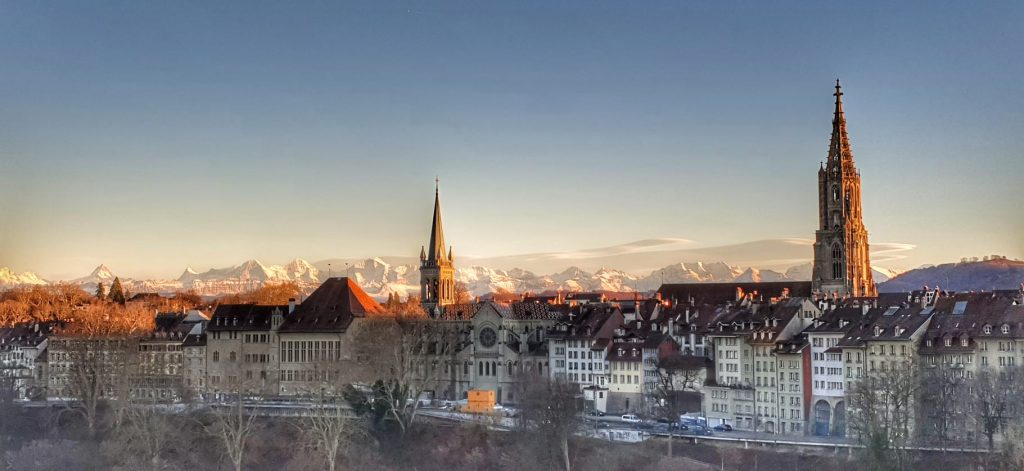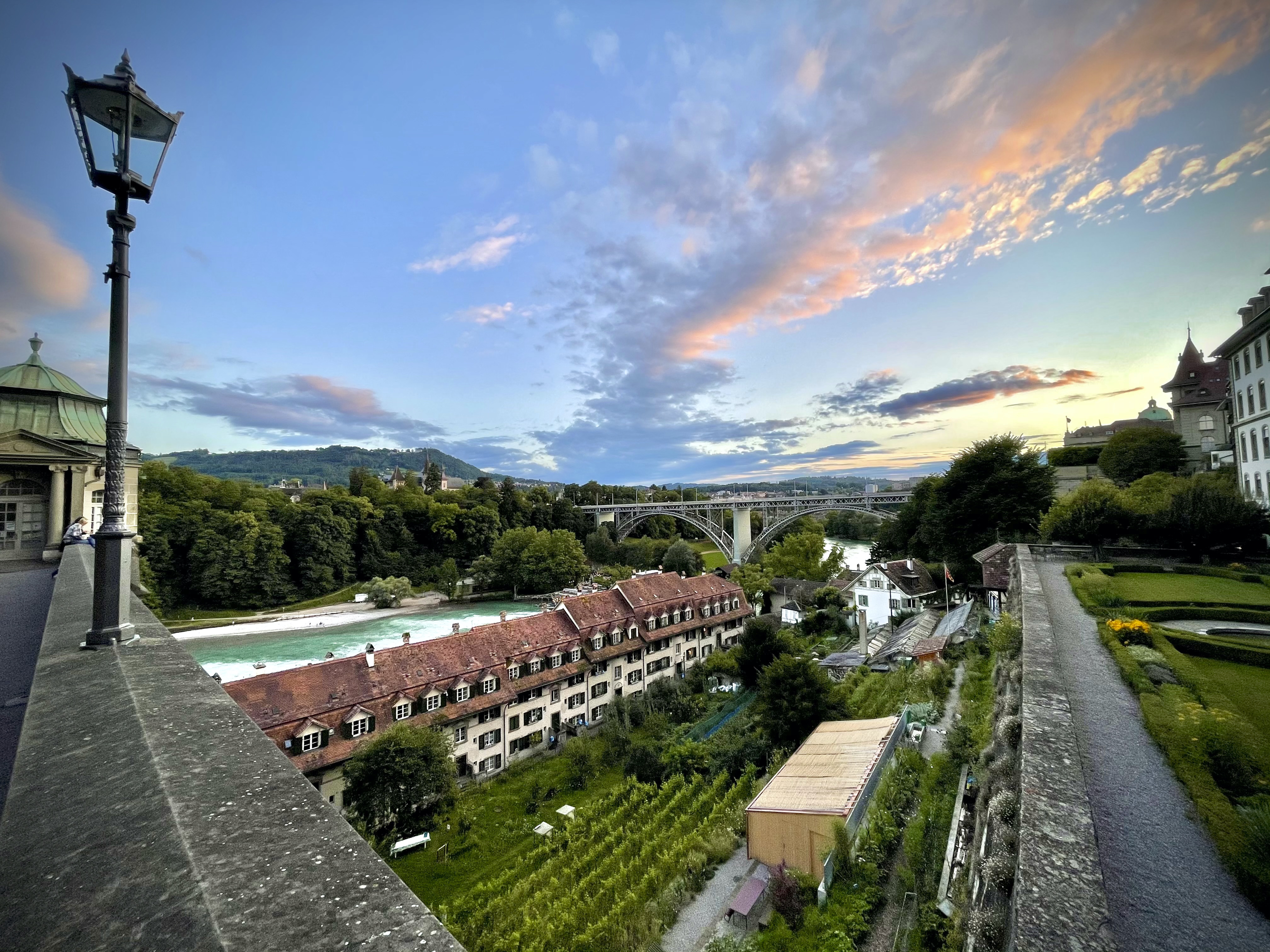
Let’s start with a little bit of history: PART 1
In 1291, representatives of three cantons got together and formed an alliance that became known as the Waldstätte or ‘forest cantons.’ This group consisted of Uri, Schwyz and Unterwalden. Today, Switzerland has 26 cantons, including Bern which is the country’s capital city, a canton and a superb location from which to launch a little bit of Swiss exploration.
Bern’s mediaeval town centre is a listed World Heritage site. Here you feel and experience hundreds of years of history forged with antiquity and offering a multitude of interesting things to do and see.
Whilst Bern offers an abundance of restaurants, bars and cafes, the city’s surrounding villages give you a picturesque and tranquil insight into life in rural Switzerland. Venturing out from the city centre is a great way to discover the canton’s more quintessential, peaceful and relaxing characteristics. I’ll get to the bit about the randy monks further down! But first…
If you are fit, walk or cycle up to the Bantiger, which is just above the village of Bantigen. There’s a communications tower you can climb, and the view will not disappoint. It’s astounding, panoramic and surprisingly access to the tower is free! Oh, before I forget – and take a picnic!
If you are not feeling energetic, grab an all-day zone 100 + 101 inclusive travel card for CHF9.20 and head to Wabern where there’s a funicular railway to Gurten. The Gurtenbahn or funicular cost is included in your day ticket, which we think is rather good value. It also means you can hop on anything, almost anywhere, at any time, all day. At the top of the hill is a small tower (Aussichtsturm) and if you pick a perfectly clear day, this is one of the best panoramic views in the country.
In every village we’ve passed through we’ve been able to fill up our water bottles with fresh, clean, wonderfully cold, non-chlorinated mountain water and when it’s 30oC that’s really appreciated.
Wabern’s funicular railway runs every 15 minutes and takes up to 110 people, with each compartment capable of transporting 22 passenger or a staggering 1760kg – a conservative figure and an average weight of just 80kg per person. I couldn’t stop myself from doing the maths. A bit on the light side methinks for a country obsessed with cheese. I think they just walk it off!
When the summer heat wave starts to kick in, the people of Bern descend to a place called Marzili where, on the banks of the Aare River you may find a free swimming pool. Of course, you will see many a local skip the pool, jump straight into the river and merrily float downstream. You’ll also note the clever use of ‘dry bags’ and an array of inflatable devices accompanying happy drifters as they cool off in this idyllic place.
In fact, I shall go as far as to say, that if there’s one thing that you will be repetitively told is a ‘must do’ in Bern, it will be ‘to swim down the Aare’. ‘Everyone does it!’ – Well, everyone who can swim and to be honest, I suspect a few people try, who can’t swim! I’ve seen people clutching on to something inflatable, like a unicorn and hoping for the best. Don’t attempt that in the winter, it’s too cold! In fact, if you can’t swim, just don’t do it! There’s no Bondi rescue in Bern, but there are bears who have their very own swimming pool.

The big brown ‘Bears of Bern’ are a major tourist magnet, and it is hard not to go and see them. They look quite happy and content roaming around within the confines of their open-air enclosure. Other than the Zytglogge, the bears of Bern may be the most photographed attraction in the city. But what about the monks? I’m getting there!

Zytglogge in English translates from Swiss-German into ‘time bell’. However, for the purpose of directing lost tourists, it tends to be referred to as the ‘Clock Tower’. Since 1218 this tower has slowly been transformed into an iconic and easily recognisable landmark. In 1530 an astronomical calendar clock and a musical mechanism were added to the structure. This popular attraction now includes four minutes of revolving figures which include dancing bears, a jester and even a rooster. But this old gateway was not initially built to inform local inhabitants of the time of day, nor help remind Einstein to stop for lunch, it was once a guard tower and later a prison for women who had been caught or accused of having sex with priests or monks. Yes – you read that correctly!
In 1334, the tower housed adulterers, thieves and my favourite ‘priest’s whores’. Seriously! I know, I know – very different times indeed. We can take it for granted that no priest at the time succumbed to any form of punishment. Clearly it would have been deduced that the maiden concerned had led the priest astray! One can only imagine that the prison was a fairly busy place with regular visits from members of the clergy claiming they needed to save a soul from damnation! It burnt down in 1405. I wonder if it was struck by lightning. An act of God – surely!
Women of the 14th Century had a really tough and challenging time. If they didn’t die during childbirth or succumb to one of the many rampant diseases plaguing society, there was a chance of being tried for witchcraft. If all that wasn’t quite bad enough, if someone didn’t Iike you, they just needed to shout out ‘she shagged a monk’ and you’d be carted off to prison.
Now, you may be wondering, ‘Why is the symbol of Bern a bear and why are they here?’ Good question. Let’s jump back to 1191 and to Duke Berthold V of Zähringen. ‘Berty’, as he was probably known to his friends, liked hunting and announced he would call his new town after the first animal they killed. So, you know you could be visiting ‘Squirrel’ or ‘Goat’, but luckily Bern won the day due to a bear popping up amongst the trees or perhaps it was a goat and Berty was forced to change his proclamation to, ‘Maybe the second animal gentlemen!’ because ‘Welcome to Goat!’ does sound a bit odd especially considering that it is now the capital. So that’s the story of the origin of the name Bern from Bär meaning bear.
However, as always there is a second theory and not one of mine on this occasion. There was a settlement in the area called Brenoder. This is an old Celtic name. Bern is also a Scandinavian baby name, which means ‘Strong as a bear’, but it wasn’t named by a Viking. It probably wasn’t named after Verona either, which was once called Bern. This would surely have meant that Shakespeare’s play would have been called ‘The Two Gentlemen of Bern’, and not Verona, and that sounds rather odd. So that takes us to Brenodor and the Bern Zinc Tablet, which was discovered in 1984. This 9.1 x 7.2cm Gobannus Tablet is inscribed in Gaulish and reads:
ΔΟΒΝΟΡΗΔΟ ΓΟΒΑΝΟ ΒΡΕΝΟΔΩΡ ΝΑΝΤΑΡΩΡ
This is a mixture of Greek and Latin letters. It makes a little more sense when you consider that two people probably contributed to the writing.
‘You do a letter and then I’ll do a letter’ – now how did that happen?
Anyway, put all that on an epigraphic fast cycle and add some etymology spin and we get this:
Dobnoredo Gobano Brenodor Nantaror
Dobnoredo means ‘World + Travel’ so it’s describing Gobannus.
Gobannus we know was a Gallo-Roman God.
Brenodor is a place name, probably now Bern.
Nantaror is likely to refer to the Aare River and the valley it runs through.
Someone, somewhere near Bern went to quite a lot of trouble to write a dedication to ‘Gobannus, the world traveller from the people of the valley of the Aare’. This second theory suggests that the old settlement name, Brenodor went through a few spelling alterations and eventually became Bern. Yeah well – I prefer the bear in the forest story! It’s so much easier to follow and just try and get any alternative theory past a local Bernese inhabitant and you risk a verbal scolding and a week in the clock tower with a randy monk.
As you potter around Bern, you may notice the letters YB everywhere. Yellow on black tends to stick out. When I first arrived in Bern, I made the mistake of asking what on earth this YB motif stood for and it all got rather confusing for a wee while:
‘Oh – this is the Young Boys’ a friend replied.
‘What are they, a boy band?’ I asked whilst feeling mildly perplexed.
‘Everybody here likes Young Boys!’ he continued as I looked at him sustaining an air of great concern.’ He continued.
‘Oh – the local football team in Bern are called the Young Boys and they play at a place called Wankdorf!’ he said.
‘Where?’
‘Wankdorf!’
‘Good Lord! – How on earth did they get that name, where’s Wankdorf and why is it all in English?’ I mused with a frown of foreign incredulity.
It was then that I started to notice all the merchandise sold by the Bern Sports Club ‘Young Boys’. They have scarves for the cold winter days, baseball caps, stickers for whacking on lampposts and every second car bumper, coffee cups, keyrings, t-shirts and soccer balls galore. And this is all very good, until you get to the supermarket and discover you can purchase ‘Young Boy’s Sausage’. It was at that point that I started to question the marketing. What on earth were they thinking?
‘Yeah – but we don’t call it that Bruce, we just say YB Wurst!’ my friend reassuringly informed me.
‘Oh! – Well that makes a big difference!’ I said.
Another interesting and wonderfully weird site to see in Bern is the Kindlifresser. Built in 1546, this sculpture, set within a water fountain, depicts a man eating a sack of babies! Yep – you read that right as well!
Located in the Kornhausplatz, the ‘Child Eater of Bern’ has scared the crap out of children for centuries. Most adults seem to stroll past it oblivious to its grotesque nature that belongs within a medieval nightmare. What I like, is that no one really knows why it is there or what it truly represents. In another twenty-odd years it will have stood for 500 years.
The art of scaring children may be fading in Switzerland, though on occasion the practice does make a comeback. On 6th December in some parts of the country strange creatures emerge. Samichlaus is Swiss German for Santa Claus or to be more accurate St Nicholas. Samichlaus does not always travel alone in Switzerland. He is often accompanied by a nasty looking side-kick called Schmutzli, who punishes naughty children with his broom stick. You’d think that would be enough to put small children into a state of perpetual fear and encourage year-long good behaviour, but there you would be wrong.
There is another character called, ‘Sträggele’ who lurks deep within Swiss folklore. The ‘Sträggele’ is a Swiss demon or witch who likes to steal disobedient children and even eat them! Another fine example is a seven-foot sinister-looking serpent with a cat’s head called a ‘Stollenwurm’. If you go to Valais and into the valley of Lötschental, beware of the Tschäggättä. Among other habits, these furry creatures apparently like tossing soot at people. You will notice that the Swiss really do act very differently when wearing masks!
Above the entrance to the Bern Münster or Bern Minster is an incredible representation of heaven and hell. This ‘Reformed Swiss Cathedral’ took quite a while to finish. They started building it in 1421 and finally finished it in 1893. It is famous for being the tallest cathedral in the country and there’s 312 steps you can climb, providing your legs can manage the task. The view is spectacular.
The Protestant Reformation started in 1517. Sparked by the actions of Martin Luther who nailed his Ninety-five Theses to a church door in Wittenberg in Germany, the movement was well underway in Zurich by 1525. The so-called clean up involved the abolishment of Catholic mass, the removal of numerous objects from within churches including statues, paintings, frescoes and alters. Even organs were taken away because they were deemed to be ‘the devil’s bagpipes’. What a strange time to have lived! In 1528, Bern became a fully-fledged member of the Reformist movement and with it, icons began to topple. The Bernese City Council ordered the removal of numerous statues and images that offended the Protestants. These statues which were venerated by Catholics were pulled down and became rubble for the foundations of ‘Garden Terrace’. In 1986, during renovation work many of these dismembered statues were rediscovered and moved to the local History Museum. So you see, smashing up statues is hardly a new phenomenon.
Once you’ve soaked up Bern’s amazing history, had a dip in the Aare, climbed the cathedral tower, said ‘hello’ to a bear or two and got your photo of the ‘baby eater’, do enjoy one of Bern’s many restaurants. If you are curious and wish to make some new acquaintances the social group What’s Up Bern has over 3000 English-speaking members and they frequent such fine establishments as McCarthy’s Irish Pub and Nelson’s Bar. For a more romantic scene may we suggest the wine bar Caveau 7 which has an exceptionally good selection of wines and wine tastings.
Enjoy Bern! We do.




No Comments
Leave Comment